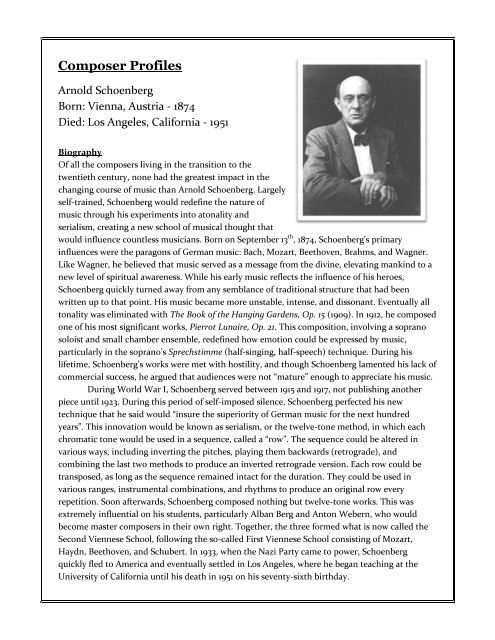Arnold Schoenberg - Andrew Lesser Music
Arnold Schoenberg - Andrew Lesser Music
Arnold Schoenberg - Andrew Lesser Music
- No tags were found...
Create successful ePaper yourself
Turn your PDF publications into a flip-book with our unique Google optimized e-Paper software.
Composer Profiles<strong>Arnold</strong> <strong>Schoenberg</strong>Born: Vienna, Austria - 1874Died: Los Angeles, California - 1951BiographyOf all the composers living in the transition to thetwentieth century, none had the greatest impact in thechanging course of music than <strong>Arnold</strong> <strong>Schoenberg</strong>. Largelyself-trained, <strong>Schoenberg</strong> would redefine the nature ofmusic through his experiments into atonality andserialism, creating a new school of musical thought thatwould influence countless musicians. Born on September 13 th , 1874, <strong>Schoenberg</strong>’s primaryinfluences were the paragons of German music: Bach, Mozart, Beethoven, Brahms, and Wagner.Like Wagner, he believed that music served as a message from the divine, elevating mankind to anew level of spiritual awareness. While his early music reflects the influence of his heroes,<strong>Schoenberg</strong> quickly turned away from any semblance of traditional structure that had beenwritten up to that point. His music became more unstable, intense, and dissonant. Eventually alltonality was eliminated with The Book of the Hanging Gardens, Op. 15 (1909). In 1912, he composedone of his most significant works, Pierrot Lunaire, Op. 21. This composition, involving a sopranosoloist and small chamber ensemble, redefined how emotion could be expressed by music,particularly in the soprano’s Sprechstimme (half-singing, half-speech) technique. During hislifetime, <strong>Schoenberg</strong>’s works were met with hostility, and though <strong>Schoenberg</strong> lamented his lack ofcommercial success, he argued that audiences were not “mature” enough to appreciate his music.During World War I, <strong>Schoenberg</strong> served between 1915 and 1917, not publishing anotherpiece until 1923. During this period of self-imposed silence, <strong>Schoenberg</strong> perfected his newtechnique that he said would “insure the superiority of German music for the next hundredyears”. This innovation would be known as serialism, or the twelve-tone method, in which eachchromatic tone would be used in a sequence, called a “row”. The sequence could be altered invarious ways, including inverting the pitches, playing them backwards (retrograde), andcombining the last two methods to produce an inverted retrograde version. Each row could betransposed, as long as the sequence remained intact for the duration. They could be used invarious ranges, instrumental combinations, and rhythms to produce an original row everyrepetition. Soon afterwards, <strong>Schoenberg</strong> composed nothing but twelve-tone works. This wasextremely influential on his students, particularly Alban Berg and Anton Webern, who wouldbecome master composers in their own right. Together, the three formed what is now called theSecond Viennese School, following the so-called First Viennese School consisting of Mozart,Haydn, Beethoven, and Schubert. In 1933, when the Nazi Party came to power, <strong>Schoenberg</strong>quickly fled to America and eventually settled in Los Angeles, where he began teaching at theUniversity of California until his death in 1951 on his seventy-sixth birthday.
Works<strong>Schoenberg</strong>’s earliest known works illustrate a gravitation toward complicated thematicprogressions, flowing in unbroken phrases directly opposite to the ideals of the late-Romanticmovement. Though retaining influences of Wagner, particularly in Transfigured Night, Op. 4,<strong>Schoenberg</strong> quickly reached the outskirts of chromatic harmony. In the period between 1907 to1909, <strong>Schoenberg</strong> departed from tonality altogether, producing works such as The Book of theHanging Gardens, Op. 15 and the Five Orchestral Pieces, Op. 16. In these works, there is noresolution to any tonic note, nor is there any sense of tonal center entirely. <strong>Schoenberg</strong> called thisthe “emancipation of dissonance”, where tones are “set free”, not relying on any kind of triadicstructure. This kind of music was labeled by critics as “atonal”, which is still in use to the presentday. <strong>Schoenberg</strong>’s melodies become more or less smaller, more compact, versions of themselves,sometimes as few as three or four notes. These “cells” as they are called, are altered to producenew pitch combinations that are related, yet can create individual phrases. This period of<strong>Schoenberg</strong>’s work leading up to World War I is referred to as his Expressionist period.Expressionism, the complete opposite of Romanticism, is the quality of dealing with the innernature of the human psyche. It is straightforward, intense, and distorted, resulting in a raw, barestructure that reflects the complicated nature of the subconscious. <strong>Schoenberg</strong>’s most famouswork, Pierrot Lunaire, Op. 21, illustrates a disturbing insight into the nature of the mind in itstwenty-one songs. In 1911, <strong>Schoenberg</strong> published his Harmonielehre (Theory of Harmony), whichhas become one of the twentieth-century’s central texts on musical composition.During World War I, <strong>Schoenberg</strong> wrote little, believing his previous work had notachieved the grand design that he felt he was meant to create. The resulting twelve-tone methodthat he pioneered divided composers into those who followed <strong>Schoenberg</strong>, such as Webern andBerg, and another camp that favored the preservation of tonality, like Stravinsky and Prokofiev.After this period of experimentation came a mass output of creativity, all relying on the twelvetonerow. A three act opera, Moses und Aron, was started between 1930 and 1932, but remainedunfinished at the composer’s death. In 1933, <strong>Schoenberg</strong>’s music was denounced by the NaziParty, in part because of <strong>Schoenberg</strong>’s Jewish heritage. The composer was vacationing in France atthe time, and did not return to Germany but immigrated to America, where he changed his familyname from Schönberg to <strong>Schoenberg</strong> upon becoming an American citizen in 1941. During his finalyears in America he developed a renewed interest in tonality, evident in the Theme and Variationsfor Band, Op. 43. Though this may seem a contradiction to <strong>Schoenberg</strong>’s compositional ideology,<strong>Schoenberg</strong> referred to himself as a “conservative revolutionary”, extending the current traditionof music but not intending to replace it. In his music the world saw a completely new form ofmusical composition, and <strong>Schoenberg</strong>’s seminal importance in the development of twentiethcenturymusic cannot be overstated.Suggested ListeningTransfigured Night, Op. 4 (1899); The Book of the Hanging Gardens, Op. 15 (1909); Five OrchestralPieces, Op. 16 (1909); Pierrot Lunaire, Op. 21 (1912); Four Orchestral Songs, Op. 22 (1916); ViolinConcerto, Op. 26 (1936); Theme and Variations for Band, Op. 43 (1943); A Survivor from Warsaw,Op. 46 (1947); Moses und Aron (unfinished, 1932)










